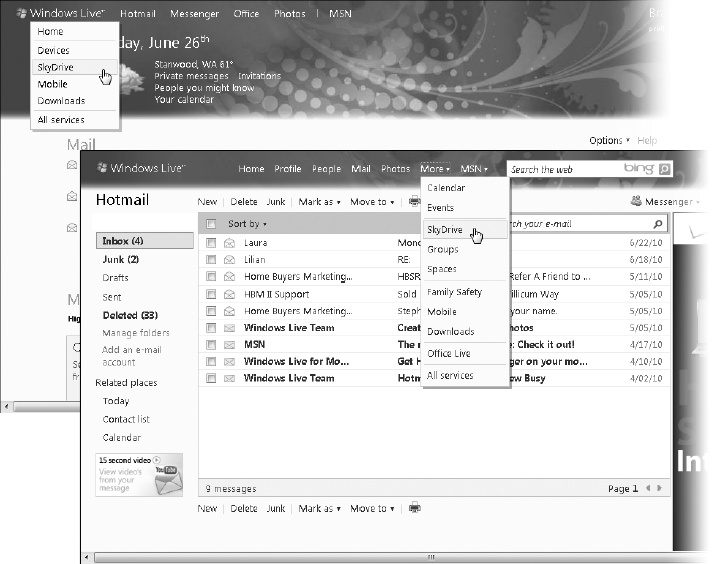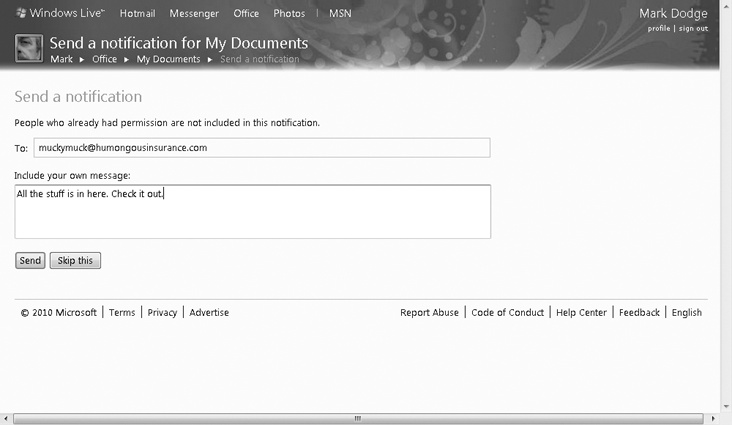Many of us signed up for free Hotmail accounts years ago, and then watched as capacities increased and services were added. Hotmail has evolved into Windows Live, a continually growing collection of services, most of which are still free. You might not even know you have it, but if you have a Hotmail/Windows Live account, Windows Live SkyDrive provides you with 25 gigabytes of free online storage. (Visit www.windowslive.com for more information.) It’s a private disk drive on the Web, and it’s accessible using any Internet-connected computer. And even if you hesitate to store sensitive documents “in the cloud,” it’s still pretty handy to have a 25-gigabyte virtual flash drive you can access from anywhere.
If you already have a Windows Live ID, you can begin using SkyDrive directly from Excel 2010 by clicking the File tab, Save & Send, Save To Web, and then clicking Sign In. As you can see in Figure 26-1, the Save To Windows Live area includes a Save As button (it’s always Save As) and a New folder button. If you don’t have a Windows Live ID, there’s a link you can click to sign up for one.
After you save a document to SkyDrive, it appears on the list of files that is displayed when you click the File tab and then click Recent. Handily, the list of recent workbooks includes the physical path, so you can tell the difference between the file on your computer and the copy you just saved on SkyDrive. If you click the file you just saved in the Recent list, it opens from SkyDrive. You have to re-enter your Windows Live logon information when you open a file stored on SkyDrive, but only once per session.
The Save To SharePoint command on the Save & Send screen behaves similarly to the Save To Web command. You are prompted for logon information, and then subsequent visits to the Save & Send screen display Save To SharePoint on the right side of the screen, with a list view of the last folder visited, similar to the foreground screen in Figure 26-1.
If you open your browser and log on to your Windows Live account, you can set permissions and manage files and folders. To do so, log on, point to the Windows Live logo to display a menu, and click SkyDrive, as shown in Figure 26-2. If no menu appears under the Windows Live logo (which might be the case if you’re working in Hotmail), click the More menu and then click SkyDrive. SkyDrive uses an icon-based interface, as shown in Figure 26-3; click a folder icon to display its contents. You can edit the access permissions for any folder except the Public folder, which is always available to anyone who knows where to find it (and therefore should be used with discretion), and the Favorites folder, which is available only to you.
SkyDrive folders can be private or shared with others whose e-mail addresses you specify. You can provide folder-level read-only or read-write access to a network of contacts or to specific individuals, whether or not they have a Windows Live account. (But it’s more secure if they do, and it’s free anyway, so why not?)
Start by opening or creating a folder in SkyDrive. Then click the Share menu, and click Edit Permissions, as shown in Figure 26-4. Use the Edit Permissions screen shown in Figure 26-5 to add users to the current folder using their e-mail addresses.
Note
One of the advantages of using the online services we describe in this chapter is that they are self-improving. When it’s time to update the site or add new features, it just happens. No downloads or installations are necessary. That’s great, but it also means that some of the screens you see in this publication might look different by the time you read this.
Note
Don’t abandon your healthy sense of self-preservation. It is always prudent to keep personal and professional information secure, so you should not allow sensitive files to sit in a shared folder for no reason. Remove the critical stuff when you’re done.
The slider at the top of the Edit Permissions screen enables you to specify general settings for the folder. As you slide the indicator upward, list boxes appear to the right, letting you specify what kind of access is allowed at each level. An on-screen note advises you that if you select anything higher than Some Friends, you may also be publishing to “connected services.” Windows Live enables you to connect to Facebook and MySpace (see the Windows Live home page), so be careful with your permissions if you choose to do this.
You can add users to your permissions list under Add Specific People, and you can then select the level of access you want to grant to each one. As you can see in Figure 26-5, you select one of two options in the menu adjacent to each e-mail address: Can View files or Can Add, Edit Details, And Delete Files.
Your users need to know how to access your shared folder, so each time you add another user, a screen like the one in Figure 26-6 appears, allowing you to send an e-mail message containing a link to the shared folder.
SkyDrive is not just for collaboration. It’s also useful for your own purposes, of course, especially if you often use computers in different locations. You can store files you need to access from both work and home in a private folder on SkyDrive. (This book was actually created using a SkyDrive folder as the central distribution point, your team of humble wordsmiths being spread out across the planet as they are.)






